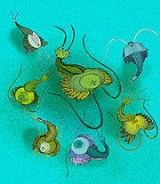
Kazacharthra
Encyclopedia
Kazacharthra is an extinct order
of branchiopod crustacean
s, closely related to the living order
Notostraca
(the tadpole shrimp). Kazacharthrans lived in marshes and ponds in the Upper Triassic
of Western China
and Mongolia
, and in Lower Jurassic
Kazakhstan
(where their fossils were first found, hence the name). It is presumed that the kazacharthrids lived much like their living relatives, in that they were opportunistic omnivore
s that fed on any available food source, from bacteria
l biofilm
s to detritus
to smaller animal
s that could be overpowered (i.e., fairy shrimp
, small or recently hatched amphibian larvae, smaller members of the same species, etc).
The kazacharthrans are distinguished from tadpole shrimp in that they are much larger (carapace length ranging from 0.6 to 5 centimeters), having uniquely shaped, heavily sclerotized, heavily mineralized carapaces, and plate-shaped telsons The carapace, or headshield has a distinctive pattern of tubercles, typically with a central-anteriorly located tubercle that may or may not house the compound eyes, and other, distinctively shaped tubercles that may represent attachment sites for mandibles.
There are seven genera recognized, placed within a single family, Ketmeniidae (invalid name/synonym = Paratriopsidae).
Order (biology)
In scientific classification used in biology, the order is# a taxonomic rank used in the classification of organisms. Other well-known ranks are life, domain, kingdom, phylum, class, family, genus, and species, with order fitting in between class and family...
of branchiopod crustacean
Crustacean
Crustaceans form a very large group of arthropods, usually treated as a subphylum, which includes such familiar animals as crabs, lobsters, crayfish, shrimp, krill and barnacles. The 50,000 described species range in size from Stygotantulus stocki at , to the Japanese spider crab with a leg span...
s, closely related to the living order
Order (biology)
In scientific classification used in biology, the order is# a taxonomic rank used in the classification of organisms. Other well-known ranks are life, domain, kingdom, phylum, class, family, genus, and species, with order fitting in between class and family...
Notostraca
Notostraca
The order Notostraca comprises the single family Triopsidae, containing the tadpole shrimp or shield shrimp. The two genera, Triops and Lepidurus, are considered living fossils, having not changed significantly in outward form since the Triassic. They have a broad, flat carapace, which conceals the...
(the tadpole shrimp). Kazacharthrans lived in marshes and ponds in the Upper Triassic
Triassic
The Triassic is a geologic period and system that extends from about 250 to 200 Mya . As the first period of the Mesozoic Era, the Triassic follows the Permian and is followed by the Jurassic. Both the start and end of the Triassic are marked by major extinction events...
of Western China
China
Chinese civilization may refer to:* China for more general discussion of the country.* Chinese culture* Greater China, the transnational community of ethnic Chinese.* History of China* Sinosphere, the area historically affected by Chinese culture...
and Mongolia
Mongolia
Mongolia is a landlocked country in East and Central Asia. It is bordered by Russia to the north and China to the south, east and west. Although Mongolia does not share a border with Kazakhstan, its western-most point is only from Kazakhstan's eastern tip. Ulan Bator, the capital and largest...
, and in Lower Jurassic
Jurassic
The Jurassic is a geologic period and system that extends from about Mya to Mya, that is, from the end of the Triassic to the beginning of the Cretaceous. The Jurassic constitutes the middle period of the Mesozoic era, also known as the age of reptiles. The start of the period is marked by...
Kazakhstan
Kazakhstan
Kazakhstan , officially the Republic of Kazakhstan, is a transcontinental country in Central Asia and Eastern Europe. Ranked as the ninth largest country in the world, it is also the world's largest landlocked country; its territory of is greater than Western Europe...
(where their fossils were first found, hence the name). It is presumed that the kazacharthrids lived much like their living relatives, in that they were opportunistic omnivore
Omnivore
Omnivores are species that eat both plants and animals as their primary food source...
s that fed on any available food source, from bacteria
Bacteria
Bacteria are a large domain of prokaryotic microorganisms. Typically a few micrometres in length, bacteria have a wide range of shapes, ranging from spheres to rods and spirals...
l biofilm
Biofilm
A biofilm is an aggregate of microorganisms in which cells adhere to each other on a surface. These adherent cells are frequently embedded within a self-produced matrix of extracellular polymeric substance...
s to detritus
Detritus
Detritus is a biological term used to describe dead or waste organic material.Detritus may also refer to:* Detritus , a geological term used to describe the particles of rock produced by weathering...
to smaller animal
Animal
Animals are a major group of multicellular, eukaryotic organisms of the kingdom Animalia or Metazoa. Their body plan eventually becomes fixed as they develop, although some undergo a process of metamorphosis later on in their life. Most animals are motile, meaning they can move spontaneously and...
s that could be overpowered (i.e., fairy shrimp
Fairy shrimp
Anostraca is one of the four orders of crustaceans in the class Branchiopoda; its members are also known as fairy shrimp. They are usually long . Most species have 20 body segments, bearing 11 pairs of leaf-like phyllopodia , and the body lacks a carapace...
, small or recently hatched amphibian larvae, smaller members of the same species, etc).
The kazacharthrans are distinguished from tadpole shrimp in that they are much larger (carapace length ranging from 0.6 to 5 centimeters), having uniquely shaped, heavily sclerotized, heavily mineralized carapaces, and plate-shaped telsons The carapace, or headshield has a distinctive pattern of tubercles, typically with a central-anteriorly located tubercle that may or may not house the compound eyes, and other, distinctively shaped tubercles that may represent attachment sites for mandibles.
There are seven genera recognized, placed within a single family, Ketmeniidae (invalid name/synonym = Paratriopsidae).

